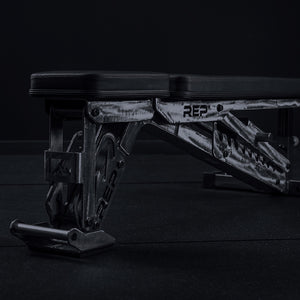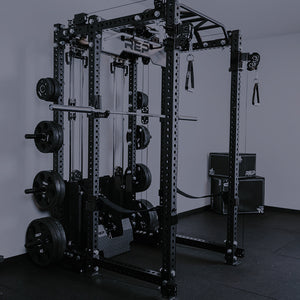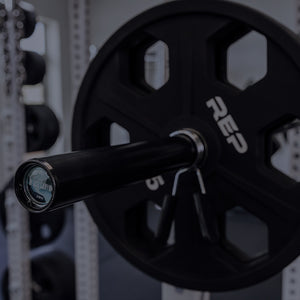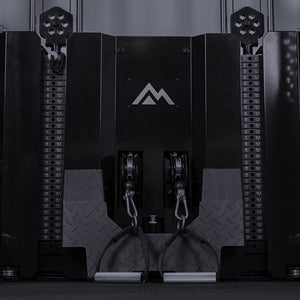
You can feel it, but you can’t see it. What’s going on beneath the surface of your barbell plays a huge role in how you experience your lifts.
This isn’t a philosophical metaphor; we’re talking about sleeve construction.
The sleeves are the outermost ends of a barbell – the thicker part where you load the weight plates. There are a ton of different types of sleeves and combos of features: smooth or textured, different finishes and materials, varying lengths, and different internal constructions. All of these characteristics affect how the weight feels and moves – in particular for sleeve construction, how the plates spin (or don’t spin too much) on a lift.
Different types of lifting benefit from different types of spin. Olympic weightlifting lifts want more spin, to help with things like the snatch and clean and jerk. Powerlifting moves benefit from less spin; you want the plates to feel pretty stable when you’re maxing out on a back squat. Too much turnover can throw off the balance of the bar. Some lifters (general lifters, people who want a multi-use bar, functional fitness athletes) may prefer spin somewhere in the middle of those two extremes. This allows you to use a bar for both Olympic lifts and slow, strength-focused lifts.
Here’s a look at the different types of sleeve constructions to help you pick a bar with the right guts for your goals – from high rotation to slower spins.

Bearing sleeves
Bearings are typically used for faster sleeve turnover. Bearings essentially roll around the sleeve. There are different types of bearings.
Needle bearing sleeves

Needle bearings are the gold standard for Olympic bars. They provide a precise and durable rotation. With a needle bearing, there are tiny needles that contact the actual shaft of the bar, spinning around the shaft. With a standard needle bearing sleeve, the needle rollers sit on the “outer race,” the main surface.
Bars with this sleeve construction: Teton Training Bar (15kg and 20kg).
Ball bearing sleeves
This provides a smooth rotation, but it’s not quite as durable over time and is unlikely to withstand as high of loads as a needle bearing. Ball bearings have an inner and outer race, and the balls sit between the two circles.
A ball bearing is often a solid choice for a mixed-use bar, because it provides good rotation, but it isn’t as fast as a needle bearing.
REP’s ball bearing bars are finished with super durable and strong hard chrome and black chrome. Because the bearings contact the shaft, the finish of the shaft matters. The finish isn’t just about how the bar feels on your hands and can hold up against the external elements over time; it also plays into the internal experience – beyond what you can see.
Bars with this sleeve construction: The Black Canyon Bar.
Inner race needle bearing sleeves
This is the highest end Olympic-style sleeve. It features those slick, spinning needles, plus an added inner race, so the needles don’t contact the shaft directly. Think of it as the best of both worlds. You get the benefits of needle bearings (the ability to withstand a ton of drops and a heavy load; a long lifespan; and the smoothest rotation), as well as the benefits of the inner race. That extends all those benefits by adding even more durability, a smoother rotation, and more longevity by removing all direct contact between the needles and the shaft.
Over time, needle roller can create micro-scratches on the shaft. This can wear down the shaft, creating small flat spots. After a while, those spots might get big enough that you can feel them in the rotation. The inner race solves that issue by removing direct contact. An inner race needle bearing isn’t widely used in the industry, but it’s the best of the best.
Bars with this sleeve construction: The Alpine Weightlifting Bar (15kg and 20kg).
Bushing sleeves
A bushing is a metal sleeve with no moving parts inside. Think of it as one solid piece. Whereas bearing sleeves have inner workings to them, the bushing is typically pressed into the sleeve, and it’s the bushing surface itself that rotates around the shaft. There is friction between the surface of the bushing and the surface of the shaft, so it doesn’t rotate as freely as a bearing. Because it doesn’t have those little, moving pieces that could break, a bushing sleeve can handle heavier loads. A fractured bushing is highly unlikely. That’s why you’ll see bushing sleeves on power bars.
Bronze bushing sleeves

This refers to the material the bushing is made from. Bronze bushings are the highest-end bushings, because they’re the strongest.
Bars with this sleeve construction: The Double Black Diamond Power Bar, Badlands Bar, Helios Squat Bar, Hades Deadlift Bar.
Composite bushing sleeves
Composite refers to the material the bushing is made from. Composite is a molded and machined bushing made from a proprietary material. It is designed to have low friction and be self-lubricating. Composite is durable, yet not as heavy-duty as bronze, and it provides a smoother rotation. These bushings will also last a long time – this is for a bar intended to take a serious beating, with a lot of drops and cycling (think: functional fitness).
Bars with this sleeve construction: The Colorado Bar (20kg and 15kg).
Brass bushing sleeves
These are bushings made from brass. They’re still tough, but not as strong as bronze bushings. They’re also more cost-effective for lifters on a budget.
Bars with this sleeve construction: Delta Basic Bar, Mesa Technique Bar.
Hybrid sleeves
You can also bring the different constructions together. That’s called a hybrid sleeve. There are different kinds of hybrids. You can combine both ball bearings and bushings to create a smooth rotation – but not too much. You can also combine needle and inner race needle (like the Alpine Bar). Hybrid construction means a mix of any of the above modes.
Bars with this sleeve construction: The Black Canyon Bar (15kg and 20kg) has both ball bearing and a brass bushing.
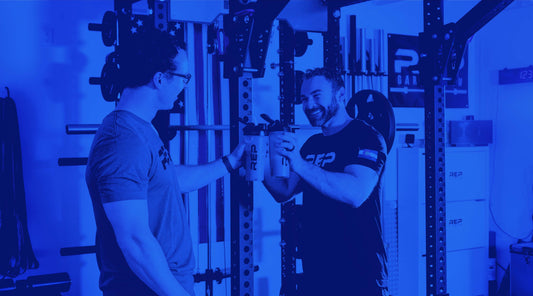
NEWSLETTER SIGNUP
Product launch information, promotions, blogs, and REP news.

